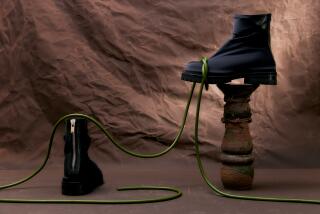THE STOGIE’S RETURN
- Share via
An attorney of my acquaintance represents a benchmark for success as it is defined in the upwardly mobile ‘80s. At 39 he is a partner in one of those “boutique” firms that specialize in the twin hometown industries of Southern California: entertainment and real estate. He rises at dawn every morning to run with his malamute along the posh streets above Sunset Boulevard. And when he leans back at day’s end at his desk--or at his favorite table at Prego--he lights up a cigar.
Yes, cigar smoking has been restored to its rightful place in a life lived well, even a life that is otherwise thoroughly chic and aerobically sound. A new generation has discovered what some of us have known all along--that a fine cigar offers all the refined, sensual pleasure that one might seek in a rare wine or a particularly imaginative piece of sushi. And connoisseurship carries with it the stately rituals of storing, trimming and lighting--all of which requires additional paraphernalia of technological precision and even opulence: a $2,000 cedar-lined rosewood humidor from Davidoff’s in Geneva, a butane lighter in sterling or gold from Dunhill on Rodeo Drive and a whole arsenal of exquisite little spikes and blades.
Why, there’s even a new line from Paris that may be the world’s first designer-label stogies--Pleiades, which sport a tasteful, Tiffany-blue logo worthy of some sparkling mineral water and which come in an Art Deco box of such beauty that an empty one will cost you five bucks. (The cigar alone is $3.) My tobacconist tells me that he’s selling nearly twice as many cigars as he did a year ago, and his new customers are buying premium brands that range from $2.50 to $4 a smoke. “We don’t even carry a $1 cigar anymore,” he says.
Yet, as the acolyte soon discovers, there is a fundamental contradiction between cigar smoking and the rarefied world of Perrier and the Sports Connection. A cigar is probably less hazardous to your health than a cigarette; unless a cigar smoker is suicidally macho, he ordinarily does not inhale. But the volume of exhaled cigar smoke creates a murderous side stream. Then, too, the cigar is linked with potbellied plutocrats in our cultural iconography. That’s why John F. Kennedy, arguably our first yuppie President, refused to smoke cigars in public.
The fact is that the cigar is something of an atavism, a throwback to a more leisurely age when the menfolk donned smoking jackets and retired to the library for brandy and double coronas. The same tendency toward masculine gatherings may be observed among cigar smokers in our own era, although we behave more like refugees than grandees. I know one young man who lights up a cigar only during the Thursday evening “probability seminar,” as he calls his weekly poker game.
It may be that the impulse toward cigar smoking reflects some deeper yearning for the stately manners and serene wisdom of our elders, a hunger for the sturdy values that are somehow embodied in the ritual. Only yesterday I saw Milton Berle in a Beverly Hills bank, and Uncle Miltie--brandishing a cigar at least 10 inches long--was being affectionately mobbed by a clutch of young women approximately the age of his grandchildren. He may be old-fashioned, but he is still revered. And, as a cigar smoker, I like to think that the stogie has something to do with it. CRYSTAL FROM DAVID ORGELL / OTHER ACCESSORIES FROM THE TINDER BOX INTERNATIONAL
More to Read
Inside the business of entertainment
The Wide Shot brings you news, analysis and insights on everything from streaming wars to production — and what it all means for the future.
You may occasionally receive promotional content from the Los Angeles Times.










